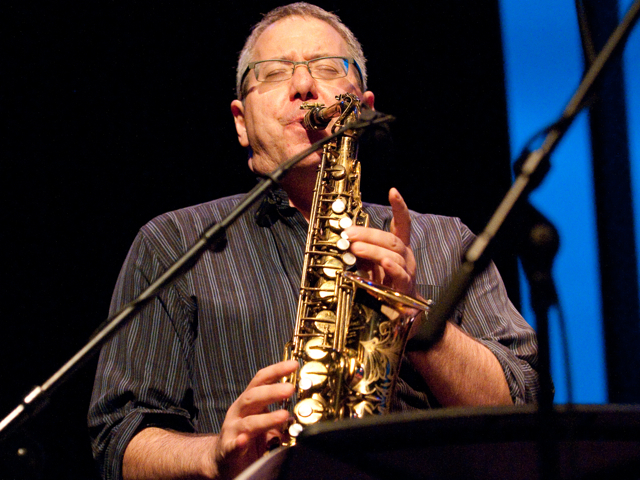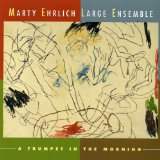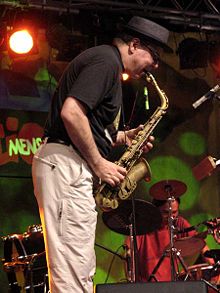
Multi-reedist-composer-bandleader Marty Ehrlich is one artist whose creative impulses I’ve grown to trust, not only from his always intriguing recordings but also from having presented him in different band configurations at both Tribeca Performing Arts Center and Tri-C JazzFest. A very thoughtful man whose bespectacled presence suggests that of a wily, witty college professor (which he is at Hampshire College), Marty is one of those inside/out players who is as comfortable in a swinging environment as he is amidst dissonance. In that regard he is much like one of his mentors, the late pianist-seeker-teacher Jaki Byard.
Though born in St. Paul, Minnesota Marty grew up in St. Louis, so perhaps its our shared Midwestern affinity that in part continues to draw my ears to his work. As a teen Ehrlich came under the influence of the St. Louis-based collective of restless innovators – including fellow reedists like Julius Hemphill, Oliver Lake and J.D. Parran – known as the Black Artists’ Group (BAG), an organization with much more than improvisational performance on its mind, much like Chicago’s enduring AACM. His affiliations have also included NEA Jazz Master Muhal Richard Abrams, John Zorn, Myra Melford and the great Haitian drummer Andrew Cyrille.
For his latest release A Trumpet in the Morning Marty Ehrlich has taken an expansive approach and engaged a large ensemble canvas on which to paint his original compositions. The band includes a number of notable players, such as drummer Matt Wilson, saxophonists Parran (who doubles as narrator), Howard Johnson (on baritone) and Andy Laster; trumpeters E.J. Allen, Ron Horton and James Zollar; trombonists Curtis Fowlkes and Ray Anderson, percussionist Warren Smith, pianist James Weidman, and longtime compadre guitarist-bassist Jerome Harris among an auspicious posse of others. Clearly some questions for Marty Ehrlich were in order on the nature of this release.
What’s been your experience leading and/or recording in large ensemble formats?
In many ways I have had a traditional jazz apprenticeship in the big band tradition, if with many paradigm shifting composers. I played in big bands throughout high school, as many students did at that time. (Public education had music programs, and ‘stage bands’, whatever that meant, were more common than not.) At the New England Conservatory, the core of our work in the Afro-American Music program was playing Jaki Byard’s and George Russell‘s Jazz Orchestra music. What couldn’t you learn from each of these masterful, visionary bodies of music? Gunther Schuller was in his Ellington performance period, and I got to do Ellington transcriptions with him.
When I got to NYC in 1978, the first tour I did in Europe was with the Anthony Braxton Creative Music Orchestra, 20 musicians strong. When George Russell put together his New York big Band, he asked me to be in it, which meant a lot to me. We ended up playing 30 or so nights at the Village Vanguard, pretty cool for your first year in the Apple. (I have never played a note there since.) Jaki started doing the Apollo Stompers in NYC, at Barry Harris‘ place and Rashied Ali‘s place, and I would do that. And it seemed that I did a whole string of the BAG and AACM large ensembles, gigs, tours, and recordings. Julius Hemphill, Muhal Richard Abrams, Oliver Lake, Wadada Leo Smith, Roscoe Mitchell and others. I got to do Sam Rivers’ big band one time, during the transit strike in the 80’s, and [drummer] Ronnie Burrage and I walked from Brooklyn to Manhattan with horns and cymbals. Surely my commitment to woodwind doubling helped with getting called for this work, along with my focus on ensemble playing. The many years I spent in Anthony Davis‘ mid- size group, and then the ongoing work on his opera, X- The life and Times of Malcolm X, kept me in a large ensemble focus. Very important for me was the work of the New York Composer’s Orchestra, which Wayne Horvitz and Robin Holcomb organized and were musical directors of. We did two CD’s for New World, which is the first opportunity I got to record my Jazz Orchestra music (Pliant Plaint and After All.) If I look at the CD collection of recordings I have taken part in, it has a good number of Jazz Orchestra CD’s in it.
Since Julius Hemphill’s passing, I have conducted his Jazz Orchestra music in America and in Europe. And leading two large ensembles a year at Hampshire College where I teach has given me both experience and a forum for “comprovisation” ideas.
With this question you have pointed to the new thing for me that I took on, conducting/producing only, not leading with my horn playing and improvising. I think all the work I talk about above was crucial in preparing me for taking on this role.

What compelled you towards this project at this particular time?
There were some very concrete things that came together that helped me pull this off. But I think the most important thing to say is that the range of approaches and musical languages of my long form pieces began to connect for me in important ways. I got to a point in my life where the connections became very important to me, and I wanted to put this range of writing and conceptualizing that I had done together in one place. It had a real unity in its diversity.
There’s a school of thought that relates to maximizing radio potential for one’s music that kinda rules against extended composition, yet you have extended pieces on this recording that clock in at 20+ and 14+ minutes. (For example, for airplay on my radio program I selected the first 7:18 section of “Rundowns and Turnbacks”, but with a typical 2-hour radio program I dare not spin the entire 20:22). What’s your thinking in that regard?
To some extent, these are concert pieces, and they are about having a large canvas to fill. How are you going to fill it? How to use this large number of instrumentalist/improvisers? How to use contrast in form and language and style to make a work that builds in resonance over the time of the work? The questions that can haunt you in the middle of the night when a deadline is looming for the completion of said piece.
I love radio, I listen a lot here in NYC, and I love the unexpected nature of radio programming. I consider the role that KDNA, the Pacifica station in St. Louis MO played in my musical education to be a crucial one. (And it was probably the first place that I performed my own music live.) It is still a thrill to hear my stuff pop up here and there. I hope it helps sell a CD. (I have bought a few after hearing a cut of a colleague’s newest project.) But for this project, I didn’t think of it as a consideration for the shaping of the music.
Willard, I like your solution in the question above a lot. I hope some other programmers do the same. And perhaps you have put your finger on something. That for long- form works, which are such an important part of the jazz/Afro-American music/Creative music continuum, the artist and the company could help by making a suggestion for radio play in their mailings such as you have just shared here.
And my next recording? Nothing but hits! (Well, we’ll see.)
Achieving a certain creative balance in a large ensemble is a tricky proposition, particularly where it concerns personnel. How did you go about selecting the personnel for this project?
One thing I did was to build the ensemble up over some time, because I was recomposing and re-orchestrating all along, and I would get ideas that this player would be wonderful to have for this section or that section. Let’s call it accessing my inner-Ellington; in the model he gave us of writing for individuals and maximizing their individual skill sets and essences.
But in general, putting an ensemble together of this size for these diverse pieces is a tricky thing. (Perhaps in some ways because you have a dizzying wealth of musical voices to call on here in NYC.) My music asks that the performers wear numerous stylistic hats, much as has been asked of me in my professional life. There is a range of performance practice I love to use, let’s say from the refined to the raw. Quick changes from ensemble precision where individual voice is secondary, to a soloistic or collective context where individual voice is crucial. If you compose in a way that is pan-stylistic and pan-historical, the performance practice challenges can add up. At the same time they are situations for creative play. The musicians on this CD have all worked in this way in their own career.
I am guided by this strong belief. What I have fought against my whole career is the separation into binaries when it comes to performance practice and creative playing:
The ensemble players and the soloists, the technical players and the creative players. Jazz and Classical, Black and White, Young and Old. The social world is not past any of that; we are not in a post-racial etc. anything. But I think that to the extent that this music, in its tremendous range of endeavor, is a progressive force and a progressive community, we want to fight against limited roles for anyone.
The enthusiasm for the music and the project that I received from the musicians involved was very moving for me. I think we got some great chemistry on the recording. I love hearing all the different creative voices within the music I wrote.

If nothing else, that concert you did at Tribeca last year proved that you have an ear for spoken word narratives as part of your presentations. What was it about Arthur Brown’s “A Trumpet in the Morning” that compelled you to write music and use that narrative as the centerpiece of this project?
Let me break your question down into two parts. The second part is easy. I made the composition A Trumpet in the Morning the centerpiece of the recording project because I think it is the most inclusive, creative work I have done in a large ensemble, large-form context. It was my desire to record this work, to realize a performance that represented what I knew was on the page, that pushed me to get the funding for the project.
As to the first part of the question, I was exposed to this poem when I was in high school in St. Louis. I connected to it in a visceral way. I can’t say how much I would have been able to explicate its many references to Afro-American music and poetry, the whole Blues continuum, though I surely had done a lot of listening, and I was living in an evolving world of racial integration. I doubt that at the time I thought much on the poems play on the central story of the Resurrection in Christianity. This is a profoundly African-American and Christian poem. If any of your readers are wondering, I am European-American and Jewish. And I am not now going to say, ‘but this work of art is universal.” Nothing is universal. (Well, death and birth, but not necessarily taxes for the wealthy. But I digress.)
What this poem does have is a lot of factors at play, and now I am speaking as a 58 year old thinker and reader. I do believe that in this poem Arthur Brown gives a powerful vision of spiritual transformation, and perhaps, just perhaps, reaches people across many different cultural backgrounds. It did for me.
I’ll point to two techniques in the poem. One is the aside of the preacher about his Florsheim shoes, the status shoes of the day. The one time I heard Arthur read the poem, he told the audience that these asides spoke to the vanity of the preacher, the self-consciousness if you will. The way these asides are mixed into the forward moving narrative of the poem, almost as a momentary brake, is very effective.
The other technique, really a place of poetic invention, is the mix of both real and surreal imagery in the poem. This is not a normal Sunday morning sermon. (For that matter, it’s not clear that the narrator here is even speaking to a congregation. He may be speaking to himself, or to God.) And to be equally clear, this is a work of imagination, not a history lesson in vernacular speech or cultural reference. i’ve been all night/ in the dew/john-revelated in the marshy bottoms/lazarused in the crook of a willow whittled/a gospel-boat from a simple reed/launched that skiff in the spittle/of a mule’s jaw/gouged a skysong from the black giant’s thigh/and shackled it to a cotton flower.
The poem moves with great force toward the moment of acceptance and insight in its concluding section. Arthur builds this forward motion into the poem, yes, like a masterful jazz soloist, playing with the rhythm of the tonal/metaphorical imagery at will. The sense of transformation by the end of the poem is palpable. The humanity of the narrator is deeply felt by the listener. I think J.D. [Parran] gave a powerful expression to that element of the piece. I had written the harmonic sequence underneath him for the last section of the poem to have a rising feeling, not ever fully resting, to be in a state of ongoing modulation. J.D. got to the end of the poem with some time to spare before the soprano sax solo. He just starts wailing, and it was the perfect bridge between the sections. Then the sax solo settles into the chord sequence that is more rooted, as a place of resolution to sing from. I think it is moments like this that are what we mean by the collective spirit of the music.
Information: www.martyehrlich.com
